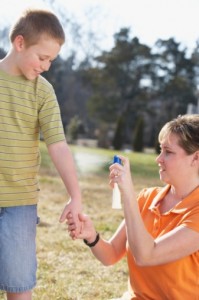
With summer comes longer days, trips to the park, lazy picnics, family vacations, and … increased exposure to mosquitoes and other biting insects. Many of my favorite places are characterized by the kinds of bugs that hang out there. (This summer, it’s Northern Michigan for me, where there are buzzard-sized mosquitos, deer flies and horse flies!) While insect-borne illnesses aren’t as common in the United States as they are in much of the world, mosquito bites are still annoying and they can pass on serious illnesses. Last year there were 158 cases of, and 9 deaths from, West Nile Virus in California alone. The Center for Disease Control (CDC) primarily recommends two types of insect repellents: DEET and picaridin.
Many people choose insect repellents with low percentages of DEET, especially when using it on their children, because they believe high percentages of DEET is dangerous. But, in fact, toxicity issues with DEET are related to frequency of application rather than concentration. Higher concentration products need to be applied less frequently, so products with higher concentrations used appropriately can actually be safer. A study cited by the CDC shows products containing 23.8% DEET provided an average of 5 hours of protection from mosquito bites; 20% DEET provided almost 4 hours of protection; 6.65% DEET provided almost 2 hours of protection; 4.75% DEET provided roughly 1 ½ hours of protection. Choose the product that matches the amount of time you’ll be exposed. In other words, if you’re going to be out for 5 hours, it’s better to use a product with 25% DEET once than 5% DEET three times. If mosquitos start biting you, it’s time to reapply repellent.
The American Academy of Pediatrics recommends that products containing DEET should not be applied to children under 2 months of age. The AAP also suggests not using products with a higher DEET concentration than 30% on children.
You also want to avoid products that are a combination sunscreen and insect repellent as the sunscreen needs to be reapplied more often than you want to be applying DEET. Use two separate products. Be careful, too, when using DEET-containing products around cameras and cell phones — it can melt the plastic!
Picaridin is a pepper-based compound that has been shown to be as effective as DEET but with lower toxicity, and it is safe for plastics. I took this product on a recent trip to Egypt (I’m a photographer–didn’t want to risk damaging my camera), and found it very good at repelling both mosquitos and biting flies — good enough that by the end of the trip my entire group was asking to borrow it. (Studies find it equivalent in efficacy to DEET.) One warning for use with kids — it IS pepper and really burns if it gets in your eyes.
Products containing oil of lemon eucalyptus are also available as an insect repellent. The oil has been found to be equivalent to very low concentration DEET, so it may be okay if you’re really not expecting to encounter a lot of insects, but it’s not a great choice if you’re headed somewhere where you’re likely to encounter mosquitoes, biting flies, or ticks.
Products that contain permethrin are recommended for use on clothing, shoes, bed nets, and camping gear (but not directly on people), and are registered with the EPA for these uses. Permethrin-treated clothing repels and kills ticks, mosquitoes, and other arthropods, and retains this effect after repeated laundering. The permethrin insecticide should be reapplied following the label instructions.
Other safety tips:
• When applying repellent on a child, apply it to your own hands and then rub them on your child. Avoid children’s eyes and mouth and use it sparingly around their ears.
• Do not apply repellent to children’s hands. (Children tend to put their hands in their mouths and rub their eyes.)
• Do not allow young children to apply insect repellent themselves; have an adult do it for them.
• Keep repellents out of reach of children.
• Do not apply repellent under clothing. Any of the repellents can be applied to the outside of clothing. If repellent is applied to clothing, wash treated clothing before wearing again.








Leave a Reply